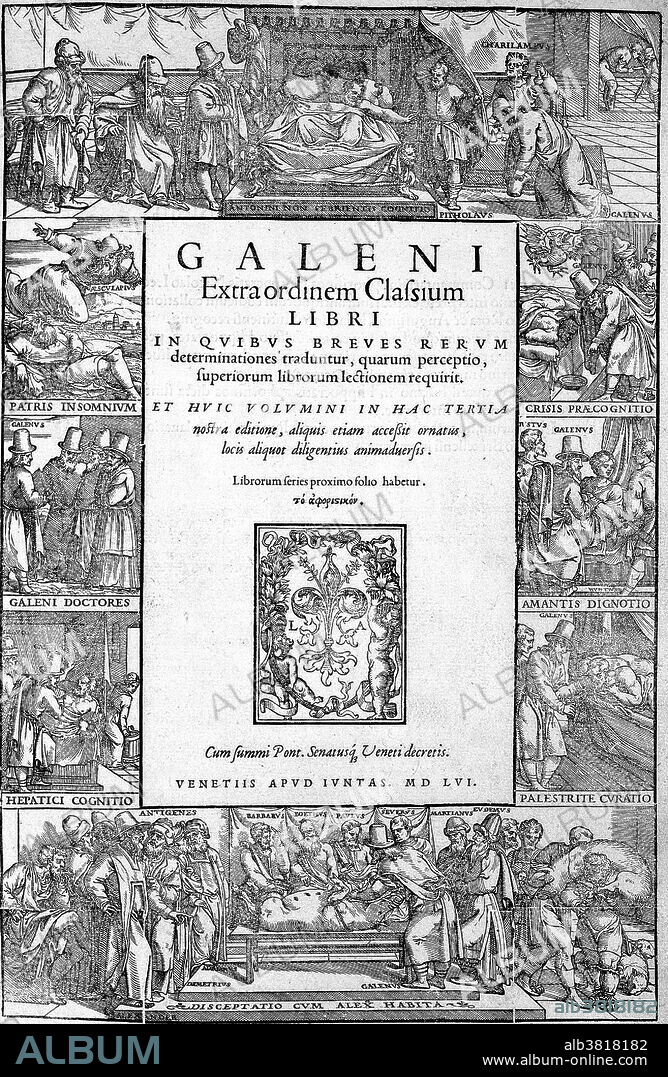alb3818182
Galen, Opera Omnia, Title Page, 1556

|
Add to another lightbox |
|
Add to another lightbox |



Title:
Galen, Opera Omnia, Title Page, 1556
Caption:
Title page of Galen's Opera omnia, with woodcut illustrations showing medical scenes that include the sick bed of Emperor Marcus Aurelius and the dissection of a pig, 1556. Galen (131-201) was born in Pergamos in Asia Minor. After receiving medical training in Smyrna and Alexandria, he gained fame as a surgeon to the gladiators of Pergamos. He was eventually summoned to Rome to be the physician of the Emperor Marcus Aurelius. Galen spent the rest of his life at the Court writing an enormous corpus of medical works. Taking Hippocrates' notions of the humors and pathology, Galen incorporated the anatomical knowledge of noted Alexandrians. A supporter of observation and reasoning, he was one of the first experimental physiologists, researching the function of the kidneys and the spinal cord in controlled experiments. Galen's works in many ways came to symbolize Greek medicine to the medical scholars of Europe and the Middle East for the next fifteen centuries. The most accomplished of all medical researchers of antiquity, Galen contributed greatly to the understanding of numerous scientific disciplines including anatomy, physiology, pathology, pharmacology, and neurology, as well as philosophy, and logic.
Credit:
Album / Science Source / Wellcome Images
Releases:
Model: No - Property: No
Rights questions?
Rights questions?
Image size:
2694 x 4128 px | 31.8 MB
Print size:
22.8 x 35.0 cm | 9.0 x 13.8 in (300 dpi)
Keywords:
1500S • 16 16TH XVI XVITH SIXTEENTH CENTURY • 16 CENTURY • 16TH CENTURY • 16TH • 2ND CENTURY • 3RD CENTURY • AELIUS GALENUS • ANATOMIST • ANATOMY • ART • ARTWORK • BOOK • CLAUDIUS GALENUS • DRAWING • EMPEROR MARCUS AURELIUS • ENGRAVING • GALEN OF PERGAMON • GALEN • GALENUS • GREEK • GROSS ANATOMY • HISTORIC • HISTORICAL DOCTOR • HISTORICAL PHYSICIAN • HISTORICAL • HISTORY • ILLUSTRATION • ILLUSTRATIONS • MARCUS AURELIUS ANTONINUS • MARCUS AURELIUS • MEDICAL • MEDICINAL • MEDICINE • OPERA OMNIA • PATHOLOGIST • PATHOLOGY • PHILOSOPHER • PHILOSOPHY • PHYSIOLOGIE • PHYSIOLOGIST • PHYSIOLOGY • SCIENCE • SURGEON • TITLE PAGE • WRITING • XVI CENTURY
 Pinterest
Pinterest Twitter
Twitter Facebook
Facebook Copy link
Copy link Email
Email

